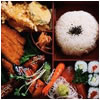Learn About Japan > Food and Agriculture in Japan > Crops > Raising Silkworms in Japan

|

Crops
- Organic Farming in Japan
- Early Mechanization of Agriculture
- Wet Rice Agriculture
- Transplanting Rice Seedlings
- Innovations in Fruit and Vegetable Farming
- Raising Silkworms in Japan
- Dairy Farming in Japan
- Beef Cattle in Japan
|

Beautiful silk thread produced from spinning silkworm cocoons.
Photo from Kodansha Encyclopedia.
Raising Silkworms in Japan
Raising silkworms, or sericulture, is a traditional side crop for Japanese farm families. To raise silkworms, the family first has to grow enough mulberry trees to feed the silkworms. They buy a supply of silkworm eggs or produce them from the previous year’s crop. The eggs are placed on large, flat trays and usually kept in the warm farmhouse attic. When the eggs hatch, the family picks mulberry leavs and feeds the silkworms, which each voraciously as they grow. The silkworms then build a cocoon around their bodies for the next stage of their development. Farmers generally sell the cocoons to a silk mill, saving a small number of seed cocoons to complete the lifecycle and produce silkworm eggs for the next crop of silkworms. The silk mill uses commercial reeling machines to unwind the silk from the cocoons and produce silk thread of various weights for weaving cloth.
Relatively few households still raise silkworms today, because silk can be produced much more cheaply in other countries. When the export of silk declined in the 1920s, the Japanese govenrment encouraged mulberry fields to be transformed into mikan orchards.
|
|
|
| Download Podcast in
English
| Japanese
|
|
Document |
Audio-Video |
Chart |
Picture |
Map
|
|
